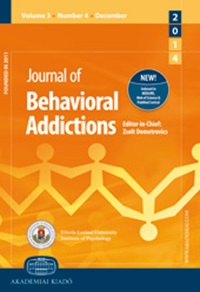捷克青少年的网络游戏障碍和危险行为:一项具有全国代表性的研究。
IF 6.6
1区 医学
Q1 PSYCHIATRY
引用次数: 0
摘要
背景和目的本研究旨在估测捷克青少年网络游戏障碍(IGD)、药物使用和其他危险行为之间的复杂关联,同时提供 IGD 患病率估测值和捷克网络游戏障碍量表-简表(IGDS9-SF)的心理测量信息。方法通过分层随机抽样,在学校环境中招募了 3,950 名捷克青少年样本。结果游戏障碍者经常使用特定物质,如药品、亚甲二氧基甲基苯丙胺和麦角酰二乙胺。相比之下,非游戏玩家使用酒精、香烟、镇静剂和安定剂以及大麻的比例较高。利用 IGDS9-SF 原始分数和日均游戏时间进行的逻辑回归显示,游戏与酗酒和吸烟之间存在 U 型关系。此外,除伪造父母签名外,行为问题(如欺凌)和游戏中的危险行为在失常游戏者中更为普遍。IGD的总体患病率为3.62%(95% CI = [3.1%,4.3%]),男性患病率(5.89%;95% CI = [4.9%,7.0%])高于女性(1.45%;95% CI = [1.0%,2.1%])。根据游戏相关问题的严重程度,游戏与药物使用行为之间的关联可能是特殊的、多方面的。此外,由于行为问题、欺凌(受害)和游戏内危险行为(如参与电子游戏中的微交易机制(如战利品箱))的发生率较高,游戏障碍者可能会变得更加脆弱。本文章由计算机程序翻译,如有差异,请以英文原文为准。
Internet gaming disorder and risky behaviours among Czech adolescents: A nationally representative study.
Background and aims
The aim of the present study was to estimate the complex association between Internet Gaming Disorder (IGD), substance use, and other risky behaviours in Czech adolescents whilst providing prevalence estimates of IGD and psychometric information regarding the Czech Internet Gaming Disorder Scale-Short-Form (IGDS9-SF).
Methods
A representative sample of 3,950 Czech adolescents was recruited through stratified random sampling in the school setting.
Results
Disordered gamers showed frequent use of specific substances such as pharmaceuticals, methylenedioxymethamphetamine, and lysergic acid diethylamide. In contrast, non-gamers had higher prevalence of alcohol, cigarettes, sedatives and tranquillisers, and marijuana use. A logistic regression, utilising IGDS9-SF raw scores and average daily gaming time, revealed a U-shaped relationship between gaming and both alcohol and cigarette use. Additionally, conduct problems such as bullying, and risky in-game behaviours were more prevalent among disordered gamers, with the exception of forging parents' signatures. The overall prevalence of IGD was 3.62% (95% CI = [3.1%, 4.3%]), with higher rates in males (5.89%; 95% CI = [4.9%, 7.0%]) than in females (1.45%; 95% CI = [1.0%, 2.1%]).
Discussion and conclusions
The Czech IGDS9-SF used in the present study showed adequate psychometric properties. The association between gaming and substance use behaviours may be specific and multifaceted depending on the severity of the gaming-related problems. Furthermore, disordered gamers may become more vulnerable due to a higher incidence of conduct problems, bullying (victimisation), and in-game risky behaviours such as engagement with microtransactions mechanics (e.g., loot box) within video games.
求助全文
通过发布文献求助,成功后即可免费获取论文全文。
去求助
来源期刊

Journal of Behavioral Addictions
PSYCHIATRY-
CiteScore
12.30
自引率
7.70%
发文量
91
审稿时长
20 weeks
期刊介绍:
The aim of Journal of Behavioral Addictions is to create a forum for the scientific information exchange with regard to behavioral addictions. The journal is a broad focused interdisciplinary one that publishes manuscripts on different approaches of non-substance addictions, research reports focusing on the addictive patterns of various behaviors, especially disorders of the impulsive-compulsive spectrum, and also publishes reviews in these topics. Coverage ranges from genetic and neurobiological research through psychological and clinical psychiatric approaches to epidemiological, sociological and anthropological aspects.
 求助内容:
求助内容: 应助结果提醒方式:
应助结果提醒方式:


